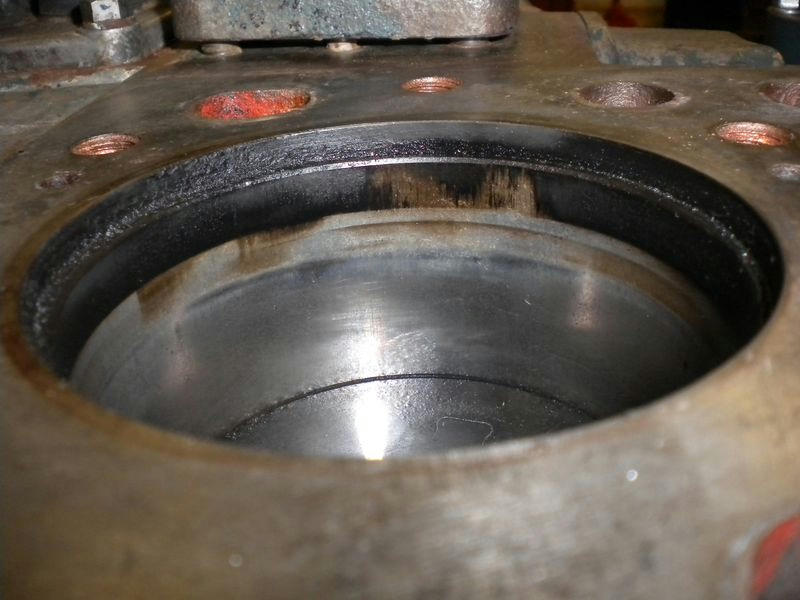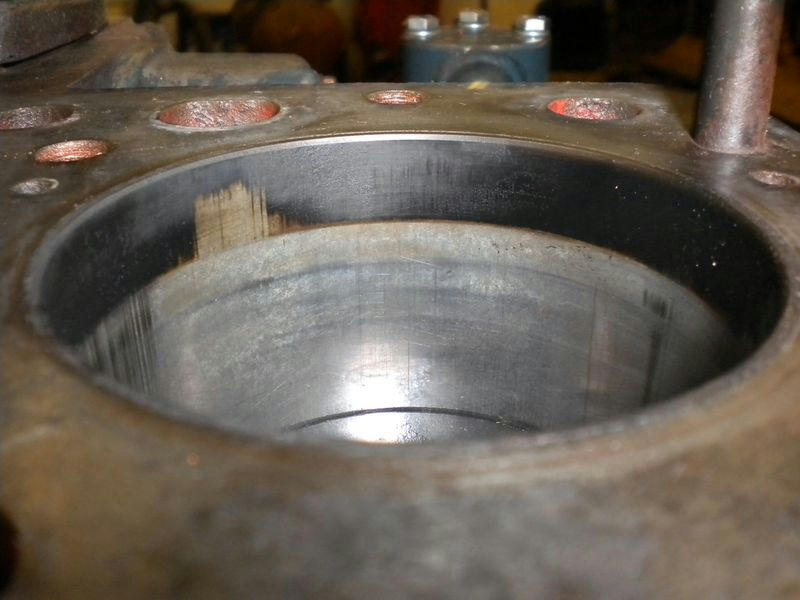*Fwooooosh* *Cough Cough!* This thing still work? Has it really been 7 weeks? Yeesh. I got stuck and then school and (and for the last two weeks Mass Effect 3) sucked away the rest of my free time and the tractor got shelved for a while. I worked on it once or twice over that period but kept running up against the wall but I'm good to go now.
Ok last time I mentioned one of the bolts that hold the front axle on had stripped. The are a few different options for repairing stripped threads. Welding in the hole and retapping, brazing or soldering in the hole and retapping, drilling out to a larger thread, or drilling the threads out and installing a threaded plug are all equally strong repairs. Though the plug is largely dependent on how well it's secured in it's hole.
As a rule large cast iron parts can't be welded. The heating of welding tends to setup stresses in the metal which causes the weld to crack again. I could've brazed in the threads but it's tricky at a 90 degree angle and I've never done it before so I threw that out. Drilling the threads out is tricky as as I don't know where oil passages in the block are. There were no good thread sizes that would fit and a plug has the same problem. Thus I'm left with a more medium strength thread repair, the helicoil. While not awful they can be a pain to work with and generally aren't as strong as a cut thread however they are they offer the most strength for the smallest hole in this case.

The repair I had to make to my lathe using a threaded plug. To install a helicoil the old thread is drilled out just large enough that the old threads are removed. Then the larger hole is then retapped using a thread with the same pitch. A specially cut coil is then inserted and this forms the a pseudo thread in the original size.
Drilling straight enough for tapping more than 3/8ths of an inch or so is nearly impossible by hand. The stripped threads were naturally in the engine block which I couldn't very well put in the drill press. So to make sure my thread ends up perfectly straight (being off straight is usually the cause of broken taps) I need a guide for my drill bit and tap. Then my lathe broke again. Weekend before last I got that fixed again and started making my guides.

I'm drilling out a chunk of 1" 6061 aluminum with the same bit that will be used to drill out the threads. The same thing can be done with a 1" thick or greater block of metal on a drill press but I had the aluminum handy. Drills don't leave a very clean or accurate hole bore so doing it this way will allow a little wobble. The correct way to do this would be a drill it out with a slightly smaller bit and then use a reamer or the lathe to open the hole up to the right size to fit the drill bit. Reamers cost money and this being aluminum this will probably be a two or three use part tops so this will be close enough.

The guide is slide over the bit between the block and drill and then held flush against the block. By going slow I was able to keep the guide on the block and drill within a few degrees of straight.

As you can see (probably) all traces of the old threads have been removed.

Another piece was drilled out using a slightly larger bit so it acts as a guide for the tap. Once the tap was started the guide was removed and the hole finished.

The helicoil is already inserted in this picture. Most of the kits come with a threaded plastic guide for this step. The helicoil is threaded onto the insertion tool (basically a bold with a lip to catch the tail on the helicoil) and then threaded into the plastic guide. From there it's threaded into the hole in the block until it's just beneath the surface. You can actually stack helicoils to allow for longer threaded areas but I didn't have room for two. Once it's in the tail (more commonly known as the tang) can be removed with a sharp edged punch and a swift hit with a hammer.
Ok last time I mentioned one of the bolts that hold the front axle on had stripped. The are a few different options for repairing stripped threads. Welding in the hole and retapping, brazing or soldering in the hole and retapping, drilling out to a larger thread, or drilling the threads out and installing a threaded plug are all equally strong repairs. Though the plug is largely dependent on how well it's secured in it's hole.
As a rule large cast iron parts can't be welded. The heating of welding tends to setup stresses in the metal which causes the weld to crack again. I could've brazed in the threads but it's tricky at a 90 degree angle and I've never done it before so I threw that out. Drilling the threads out is tricky as as I don't know where oil passages in the block are. There were no good thread sizes that would fit and a plug has the same problem. Thus I'm left with a more medium strength thread repair, the helicoil. While not awful they can be a pain to work with and generally aren't as strong as a cut thread however they are they offer the most strength for the smallest hole in this case.

The repair I had to make to my lathe using a threaded plug. To install a helicoil the old thread is drilled out just large enough that the old threads are removed. Then the larger hole is then retapped using a thread with the same pitch. A specially cut coil is then inserted and this forms the a pseudo thread in the original size.
Drilling straight enough for tapping more than 3/8ths of an inch or so is nearly impossible by hand. The stripped threads were naturally in the engine block which I couldn't very well put in the drill press. So to make sure my thread ends up perfectly straight (being off straight is usually the cause of broken taps) I need a guide for my drill bit and tap. Then my lathe broke again. Weekend before last I got that fixed again and started making my guides.

I'm drilling out a chunk of 1" 6061 aluminum with the same bit that will be used to drill out the threads. The same thing can be done with a 1" thick or greater block of metal on a drill press but I had the aluminum handy. Drills don't leave a very clean or accurate hole bore so doing it this way will allow a little wobble. The correct way to do this would be a drill it out with a slightly smaller bit and then use a reamer or the lathe to open the hole up to the right size to fit the drill bit. Reamers cost money and this being aluminum this will probably be a two or three use part tops so this will be close enough.

The guide is slide over the bit between the block and drill and then held flush against the block. By going slow I was able to keep the guide on the block and drill within a few degrees of straight.

As you can see (probably) all traces of the old threads have been removed.

Another piece was drilled out using a slightly larger bit so it acts as a guide for the tap. Once the tap was started the guide was removed and the hole finished.

The helicoil is already inserted in this picture. Most of the kits come with a threaded plastic guide for this step. The helicoil is threaded onto the insertion tool (basically a bold with a lip to catch the tail on the helicoil) and then threaded into the plastic guide. From there it's threaded into the hole in the block until it's just beneath the surface. You can actually stack helicoils to allow for longer threaded areas but I didn't have room for two. Once it's in the tail (more commonly known as the tang) can be removed with a sharp edged punch and a swift hit with a hammer.






















